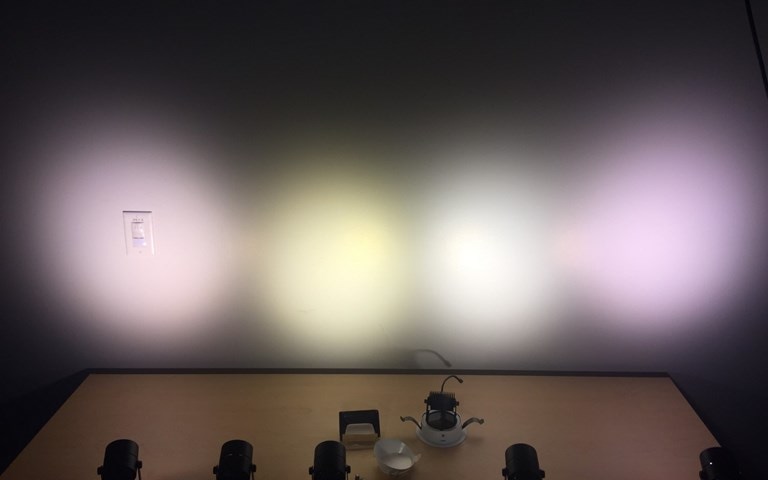Oct 17 2019
LEDs are extensively being used in low-energy displays and lighting, however, consumers from time to time find their light unpleasant or harsh. Results from a new study highlight the need to consider age-associated perception differences when developing white LED lighting that is more suitable for eyes.
 A new study reveals that age can affect the perceived tint of white light. This photo shows a very large difference in tint between different spots, which is representative of what the researchers found in the study. Though not representative of what all observe, viewers of different ages disagree on which of these sources appears “most white” when compared to a reference source. (Image credit: Soraa Inc., Freemont, Calif., U.S.A)
A new study reveals that age can affect the perceived tint of white light. This photo shows a very large difference in tint between different spots, which is representative of what the researchers found in the study. Though not representative of what all observe, viewers of different ages disagree on which of these sources appears “most white” when compared to a reference source. (Image credit: Soraa Inc., Freemont, Calif., U.S.A)
“Our study revealed that the amount of short-wavelength light a source emits together with the viewer’s age may lead to very different perceptions of a white light,” said the study team leader Aurelien David of Soraa Inc., Fremont, California., U.S.A. “LED light sources exacerbate this effect, because their emission often features large peaks of blue or violet radiation.”
The new findings have been reported in The Optical Society (OSA) journal Optics Express. They highlight that although traditional colorimetry assumes all users have the same visual response, models developed recently for color perception take age-associated effects into consideration and can be applied to predict and help lessen differences in color perception.
Today, the color of light is defined by standards based on decades-old science that doesn’t accurately predict color perception. This presents a hurdle to designing better light sources that would minimize inter-user variation and aid in the increased use of LED technology.
Aurelien David, Study Lead, Soraa Inc.
Testing white light perception
For the research, many nearly white LED sources with diverse emission spectra were shown to viewers, who were then asked to rank their apparent tint compared to that of a reference white light. The test sources were part of the scientists’ efforts to design a light source that is more sleep-friendly. They comprised of a dedicated emission spectrum wherein the short-wavelength blue light, which may influence sleep, was swapped with shorter-wavelength violet light that retains the white color of light.
“According to standard colorimetry methods, all users should have the same perception for a certain LED source,” said David. “However, we found large variations between viewers. Some thought a given source appeared very pink, whereas others thought the same source appeared very green.”
Examination of these findings showed that the perception differences were mostly driven by age. By exploring modern color science, the scientists were able to come up with a perception model that accurately took into account the inter-user perception variation they detected.
The perceived tint of these unusual LED sources is heavily influenced by the viewer’s sensitivity in the violet range, which is strongly age-dependent. Although others have observed similar variations in white-LED perception, the effect was especially easy to see because these special LEDs exacerbate it.
Aurelien David, Study Lead, Soraa Inc.
The scientists also demonstrated that the age-dependent perception effects are present in traditional LEDs such as those used both in display and lighting applications. This means that two traditional LED sources that have the same white color may seem very different to the individual observer.
Defining new color standards
“By using modern colorimetry, the design of future LED sources could be tailored to minimize inter-viewer discrepancies,” said David. “Manufacturers could use this modern framework to design lighting that is more robust against age-driven variations.”
The scientists state that having a typical calculation for age-dependent colorimetric quantities would aid manufacturers and other stakeholders include age-dependent effects into the design of future LED emitters.
We should make sure that such age-related effects do not hinder the advancement of LED technology, since they can be addressed with scientific tools that are already available, albeit not commonly used.
Aurelien David, Study Lead, Soraa Inc.
The team admitted that all 64 subjects used for this study were employees of Soraa Inc. who volunteered to take part in the research.